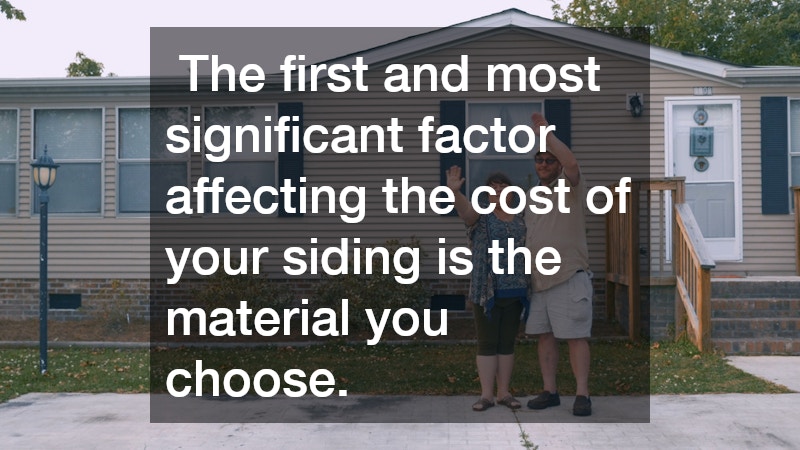

Siding is not just an aesthetic feature of your home; it’s a crucial protective layer against the elements. When considering siding installation or replacement, understanding the factors that impact the cost is essential. By doing so, you can make informed decisions about your home improvement project. In this article, we will explore the various elements that can influence the cost of siding, helping homeowners prepare and budget effectively.
Material Choices and Their Influence
The first and most significant factor affecting the cost of your siding is the material you choose. Common materials include vinyl, wood, fiber cement, and aluminum, each with its own price point and advantages.
Vinyl siding, for instance, is often seen as an affordable option with low maintenance costs over time. Wood, while providing a classic and warm aesthetic, tends to be more expensive and requires regular upkeep to prevent rot and insect damage. Fiber cement offers a balance between durability and cost, but installation can be labor-intensive, impacting total expenses.
Aside from basic material costs, homeowners must also consider color, texture, and finish. Premium options or custom finishes can significantly increase the cost per square foot. For example, opting for insulated vinyl siding can improve energy efficiency but will add to the overall expense. Additionally, styles that mimic traditional wood or stone siding are available, but they tend to be on the higher end of the price spectrum. Homeowners should weigh the benefits of each material against their budget and desired aesthetic outcome.
It’s important to engage with professional siding contractors to gain insights into the best materials suited for your climate and home style. Contractors often have access to different suppliers and may be able to offer competitive pricing. They can also advise on the most durable materials suitable for your geographic location, which can influence long-term maintenance costs. By working closely with a contractor, you can ensure that the material choice aligns with both your budget and functional needs.
The Role of Home Size and Design
Another crucial factor in determining the cost of your siding project is the size and complexity of your home. Larger homes naturally require more material, which directly increases the cost. However, it’s not just about surface area; the architectural design also plays a significant role. A home with numerous angles, eaves, and intricate designs will require more labor and precision, thus raising installation costs. Simple, boxy structures are often less expensive to cover compared to more elaborate designs.
The height of your home can also influence costs. Multi-story homes may require additional safety equipment and longer ladders or scaffolding, which can add to the labor expenses. The complexity of accessing certain areas may necessitate more time and specialized skills from the siding contractors. Simple ranch-style homes, on the other hand, are generally more straightforward and affordable for siding projects.
It’s essential to obtain detailed quotes from multiple siding contractors to understand how your home’s design will affect pricing. Contractors can assess the home’s structure and identify any potential challenges early in the planning stage. Accurate estimates help prevent surprise expenses during the project. A comprehensive assessment of your home will provide a clearer picture of what to expect in terms of labor intensity and overall costs.
Weather Considerations and Installation Timing
Weather conditions are often an overlooked factor in the cost of siding. Different materials react to weather variations such as extreme heat, cold, humidity, and precipitation. Proper installation timing can mitigate these effects and prolong the lifespan of the siding. For instance, installing vinyl siding in colder months can cause materials to crack or become brittle. Conversely, extremely hot temperatures can make certain materials more pliable and challenging to install properly.
The local climate can dictate which siding materials are most appropriate for your home. For example, areas with frequent rain might benefit from materials resistant to mold and mildew. Siding contractors can provide recommendations based on regional weather patterns and suggest materials that offer the best durability and return on investment. Having this information can guide homeowners in picking siding that balances cost with long-term performance in their specific environment.
Timing your installation to coincide with favorable weather conditions can also lead to cost savings. Scheduling projects during off-peak seasons may allow for more flexibility in pricing. Siding contractors might offer discounts or promotions during these times to keep their crews working steadily throughout the year. A well-timed installation can reduce potential delays and complications, ultimately impacting the total cost of the project positively.
Labor Costs and Contractor Experience
Labor costs represent a substantial portion of your siding investment and can vary significantly based on the experience and reputation of the siding contractors you choose. Contractors with extensive experience may charge higher rates but bring valuable expertise that ensures quality workmanship. They are equipped to handle unexpected issues and employ best practices that can minimize future repair costs. Hiring skilled contractors can translate into fewer problems down the line and efficient, timely project completion.
Location also plays a role in labor expenses. Urban areas often come with higher labor costs due to the elevated living expenses in these regions. Rural areas might offer more affordable labor rates, though this can sometimes come at the cost of fewer available skilled siding contractors. It is vital to weigh the benefits of experienced contractors against potential budget constraints to strike a balance between cost and quality.
Homeowners are encouraged to seek multiple quotes and conduct thorough research on potential contractors. Checking reviews, asking for references, and verifying credentials can provide assurance of a contractor’s capabilities. A detailed contract outlining the scope of work and pricing structure helps prevent misunderstandings and sets clear expectations. By carefully selecting a trusted and experienced contractor, you can manage labor costs effectively while ensuring a high-quality siding installation.



